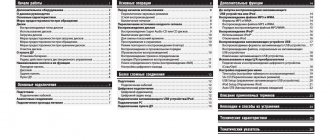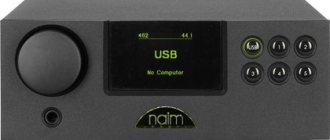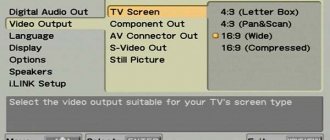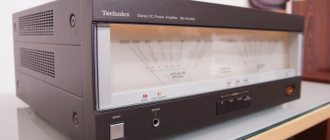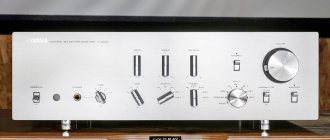Controls, Connectors and Indicators
Page 3
- Image
- Text
3
CONTROLS, CONNECTORS AND INDICATORS
(Figure 2)
PHONO INPUT jacks
. Connect these sockets to
output jacks of your turntable.
2.GND connector
. If your player
vinyl disc is equipped with a ground wire, connect it to this connector.
3. CD player input jacks .
Connect these jacks to the output jacks of your CD player.
4. TUNER input jacks .
Connect these
sockets with the output connectors of your tuner.
5. AUX/DVD input jacks .
These additional
The input jacks can be used to connect the audio outputs of a DVD player, TV multiplex/stereo audio tuner, VCR, Laser Disc player, or the audio outputs of other AV components.
6. MD
/
TAPE IN/OUT.
Connect these sockets to
the playback (output) and recording (input) sockets of your cassette or MD deck.
7. CD-R IN/OUT jacks.
Connect these sockets to
playback (output) and recording (input) sockets of your CD recorder.
SYSTEM 1/2 speaker connectors
.
Connect your speakers to these jacks.
9. Connector for remote control ( REMOTE
CONT.BUS
).
This jack can be used to connect other audio equipment that has a remote control jack. Connections are made with a special cable. OUT
bus transmits the signal to the connected equipment, while the
IN
receives the signal.
10. Power cord. 11. Power switch. Click this
switch once to turn on and again to turn off the amplifier. POWER indicator
lights up when the power is turned on and goes out when turned off.
12. Input switch INPUT
SELECTOR
.
Use this switch to select PHONO
,
CD
,
TUNER
,
AUX/DVD, MD/TAPE
or
CD-R
as a software source for recording or playback.
13. STANDBY
– lights up in standby mode.
TONE DEFEAT
switch . · When this switch is pressed, the audio signal
passes through the tone control circuits and can be adjusted using the appropriate knobs.
· When this switch is pressed, the audio signal
bypasses these circuits, and the adjustments do not work.
15. MUTING indicator.
This indicator lights up when
The mute mode is activated by pressing the MUTING
on the remote control.
note
: Check the VOLUME control setting before pressing this button to cancel muting.
If you cancel the mute mode when the volume level is too high, the speakers may be damaged. LOUDNESS
switch compensates
human hearing deficits at low volumes, enhancing low and high frequencies to produce a more natural tonal balance.
17. Adjusting VOLUME
. Turn
knob clockwise to increase the volume level.
18. BALANCE
. Turn this one
A control to correct the imbalance of a program source, such as a stereo broadcast, or to change the output level of the right and left channels. Please note that if the BALANCE
turned all the way in any direction, the sound is not produced by the speaker of the opposite channel.
SPEAKERS speaker switch
1/2
.
This switch is used to select the speaker system(s) connected to the SPEAKERS SYSTEM 1/2
on the rear panel. If both buttons are pressed, both speakers are used simultaneously. If you are using headphones for listening, set both buttons to the OFF position.
BASS controls
and
TREBLE
. These regulators
control timbre in two frequency ranges. Turn the control toward (+) to boost the corresponding frequency band, or toward (-) to cut.
TREBLE
: Adjusts the treble level.
BASS
: Adjusts the bass level.
21. The REC SELECTOR
is used to
selects whether to copy between tape decks or output from the REC OUT jack.
22. Remote control sensor. Sensor
The remote control receives the infrared signal from the remote control. Please note that the remote control must be pointed directly at the sensor for proper operation.
PHONES jack
used for connection
standard headphone plug.
Marantz Model 30
Key Features Hundreds of hours of painstaking tuning by Marantz audio experts ensures the exquisite detail and musicality for which Marantz gear is renowned. You see and feel it in the quality of every detail and notice it every time you listen. No matter your musical tastes, your music will always sound unforgettable with MODEL 30. Marantz HDAM-SA3 modules are made up of many independent parts, each hand-picked to produce clear, detailed Marantz sound. Designed to touch the senses, recreating the spirit of the first Marantz amplifiers with even simple volume adjustments.
With exquisite sound tuning, the MODEL 30 continues the spirit of legendary Marantz amplifiers. Tuned by a Marantz sound master who poured all his passion, experience and extraordinary ear into the design of the amplifier.
The most musical, accurate and detailed sound MODEL 30 is created on the basis of our own design - an amplifier module based on discrete elements HDAM (Hyper-Dynamic Amplifier Module).
Marantz Musical Premium Phono EQ Carefully designed, the phono preamp in the MODEL 30 accommodates both moving magnet (MM) and moving coil (MC) cartridges.
Adjusting the Phono Preamplifier Input Impedance For perfect matching when connecting moving coil (MC) cartridges, the MODEL 30's phono preamplifier is equipped with a convenient input impedance switch.
Technical data
Functions
Balance / Bass / Treble / Loudness Channels - 2 Current Feedback Topology Custom Components HDAM Version - SA3, SA2 High Quality Audio Components Balanced PCB Topology
General
Auto power off Maximum box dimensions (W x D x H) in mm: 534 x 522 x 255 Box weight (including product) in kg: 17.6 Detachable power cord Maximum dimensions (W x D x H) in mm: 443 x 431 x 130 Metal front panel Electricity consumption, W: 130 Remote control: RC002PMND Standby consumption, W: 0.2 System remote control functions Weight, kg: 14.8
Inputs/outputs
Audio inputs - 6 Audio outputs - 1 D-bus Gold-plated RCA connectors Headphone output Number of connectors - 2 Phono input: MM / MC Power stage input Direct IN Pre-out output
Others
Double-layer bottom plate Linear volume control Low noise OELD display Schottky diodes System unit shielding: copper
Specifications
Dumping Factor: 500 Frequency Range: 5 Hz - 50 kHz Input Sensitivity: High Level: 220 mV / 13 kOhm Input Sensitivity: MC 250 Input Sensitivity: MM 2.3 mV / 39 kOhm Output Power (8/4 Ohm RMS ) 100 W / 200 W S/N Ratio High Level 107 dB (2V input / nominal output) S/N Ratio MM / MC: 88/75 dB Distortion (THD): 0.005%
Operation, Write Operations
Page 4
- Image
- Text
4
Operation
Perform the necessary operations on the connected equipment to start playback.
For playing vinyl discs
1.
Set INPUT SELECTOR
to
PHONO
.
2.
Play the recording from your vinyl player.
3.
Use the VOLUME
To set the required volume, use the
BASS
and
TREBLE
to adjust the tone.
Note:
Make sure to set the volume to minimum
before installing the pickup head on the disc.
· Never subject the player to shock or
vibrations during playback. This may cause the needle to jump and damage the surface of the disc.
· Placement of vinyl disc player
close to speakers may cause howling noise, making it impossible to listen to recordings at high volumes.
·Never turn off the power while the needle is
is in contact with the surface of the disk.
To listen to AM/FM radio broadcasts
1.
Set INPUT SELECTOR
to the
TUNER
.
2.
Tune the tuner to the desired station.
3.
Use the VOLUME
To set the required volume, use the
BASS
and
TREBLE
to adjust the tone.
To listen to DVDs or CDs
1.
Set INPUT SELECTOR
to
CD
.
2.
Start playing the CD on your CD player.
3.
Use the VOLUME
To set the required volume, use the
BASS
and
TREBLE
to adjust the tone.
To play equipment connected to the AUX/DVD jacks
The component connected to the
AUX/DVD
on the rear panel can be listened to as follows:
1.
Set INPUT SELECTOR
to
AUX position.
2.
Set the connected equipment to playback.
3.
Use the VOLUME
To set the required volume, use the
BASS
and
TREBLE
to adjust the tone.
Write Operations
Perform the necessary operations on the connected equipment.
Playback
1.
INPUT SELECTOR switch (A)
to MD/TAPE or CD-R position.
2.
Start playing the recording on the cassette deck or recorder.
3.
Use the (B) VOLUME
to set the required volume.
4.
Use knobs (C) BASS
and
TREBLE
to adjust the tone.
Record
Start playback of the component selected as the recording source, such as a turntable, tuner, CD player, which can be recorded onto a tape or disc as follows:
1.
INPUT SELECTOR switch (A)
to the appropriate position to select the source you want to record from.
2.
Start playing the selected source.
3.
Perform the necessary operations on the recording device to record the output signal onto a tape or disc.
Using the REC SELECTOR switch
Use the REC SELECTOR
when recording from one cassette or disc to another cassette or disc, or when recording from a CD to a cassette or disc.
1.
Setting the switch to OFF
Turns off the output signal at the
REC OUT
.
Note that REC SELECTOR
should usually be set to
OFF
unless you are recording a tape or disc.
Setting it to OFF
shortens the signal path through the amplifier, which minimizes interference and other factors that cause distortion in the sound.
2.
Set the switch to SOURCE
to record onto a tape/disc a signal from the source selected by the
INPUT SELECTOR
.
3.
Set the switch to COPY
the MD/TAPE
input to
a CD-R
or vice versa.
4.
When the switch is set to COPY
You can listen to the output from another source while dubbing by selecting the source you want to listen to using the
INPUT SELECTOR
.
Remote control rc-4200pm, using remote control
Page 5
- Image
- Text
5
Remote control RC-4200PM
The RC-4200PM remote control can be used to control all Marantz AV components that are equipped with IR sensors, as well as other Marantz equipment connected to the host equipment via a remote control bus. The buttons on the remote control are arranged on the control panel according to function groups, as shown in the illustration below.
1.
Group of buttons for power management:
MAIN POWER ON – to turn on the amplifier from standby mode; MAIN POWER OFF – to turn off the amplifier into standby mode; SOURCE POWER – When the corresponding component button is pressed, FUNCTION SELECT turns the component on or off, when this button is pressed after the TUNER button, it turns the tuner on or off, when this button is pressed after the AMP button, it turns the amplifier on or off.
2.
Group of buttons for selecting sources FUNCTION SELECT. Use these buttons to select the source of the amplifier programs TUNER, PHONO, TAPE, MD, CD-R, AUX, DVD, CD.
3.
Volume control buttons VOLUME UP/DOWN.
4.
Mute button MUTE.
Other remote control buttons are not used to control the PM-4400 amplifier. For information on their use, please refer to the instructions for the relevant components.
Using the remote control
1. Remote control range
The distance between the remote control transmitter and the IR sensor on the front panel of the amplifier should not exceed 5 meters. For remote control, the remote control must be aimed directly at the sensor, and there must be no obstacles between them.
Remote control batteries
The service life of batteries installed in the remote control is about 1 year under normal conditions. Remove the batteries from the remote control if you do not plan to use it for a long time. Replace the batteries as soon as you notice that the batteries are low. (1) Remove the cover
(2) Install the batteries in the correct way
polarity +/-.
Marantz PM8005
Good afternoon fellow hobbyists. Today turned out to be a boring day and I’m writing this post with nothing to do.
So: 2 months ago I received a Marantz PM8005 amplifier. Before this I had:
1.Onkyo 9010 - a dull, ringing, bassless and toothless Mr., but detailed... 1 month and goodbye (Borzenkov GOAT).
2.Denon pma-720ae - much better, potentiometer! (but channel 1 is a little quieter, about a decibel - not critical in its price), prolonged bass, but overall - a well-armed old man with excellent macrodynamics - an audiophile device. Pair it with speakers that are fast in bass - and FIRE. In terms of timbral nuances and microdynamics, it’s a miss. Not his thing. Sold.
3. NAD c272 power. I listened to it for 2 months and couldn’t understand: the bass seemed good, but it seemed like some kind of unnatural kick drum. The blow seemed strong, but it didn’t seem to be deep, it’s not clear. At least it shows the structure of the beat clearly, that is, the beat in each track is not the same as on the Denon 720, and the texture of the bass turns out to be different everywhere (you can’t hear this on the Denon). Ok, but the middle and top are, in my opinion, WORSE! than Denon. There WERE at least the makings of a variety of timbres and after-sounds. They are not here, literally AT ALL! A device designed for a rural disco. Lots of power. Zero sophistication. But the device is “fast”. You can and should listen to heavy music. And only a heavy worker cannot do the rest. OK. - sold.
4. Marantz PM7004 - after NAD, like a breath of fresh air. Microdynamics - excellent. At low volume it's great. Bass - like Denon pma-720ae... SLOW. The case is beautiful (unlike NAD) - women love it... but damn! it's not far removed from Denona. Yes! It's made better. It is better at the top and better in the middle, or rather, just a little brighter. It is more powerful than Deno but!!….BASS….SLOW..not extreme in general. Okay... overall not bad, especially its ability to play at low volumes. You can hear EVERYTHING! and then it came to me:
5. The Marantz PM8005 is new and almost not expensive - I think: okay, I’ll sell the seventh Marantz on Avito, if anything, I’ll compare them so that when reading different posts on Stereo.ru, I can have my own point of view regarding the Marantz in general. In short: not expecting anything outstanding from the eighth Maranza compared to the seven, I buy it. And guys! It differs from the seven quite a bit. Firstly, the bass is not as textured and damped as in NAD, BUT! and not as slow as in 7004 and Denon. The impact is NATURAL, deep and elastic. To my taste - ideal. Still not suitable for extreme music (The Exploited), but genres close to extreme can already be listened to. Everything else sounds awesome! The tonal balance is awesome, the timbral variety (that is, the tone of the singer’s voice - you can directly hear the mood of how he (she) sings), the aftersound is awesome. BUT! At low volume it’s not like the 7004, you need to turn it up a little to hear everything. And when it gets a little louder, it blows away all my previous amplifiers. he is wildly NATURAL. Jazz, house, rock, etc. (except metal) - I'm in nirvana! 8005 can do this very well! This animal will stay with me longer. There is Auto OFF, the volume is adjusted by millimeter from the remote control (not like on the 7004 and Denon). The speaker terminals at the rear are large and convenient. In general, the eighth series of Maranz is RESPECT.
Care and maintenance, Troubleshooting
Page 6
- Image
- Text
6
Care and maintenance
This section describes the storage and maintenance guidelines you must follow to ensure optimal performance of your amplifier. Be sure to unplug the amplifier before performing maintenance.
Normal cleaning
The outer surface of the amplifier cabinet will remain undamaged with proper care and maintenance. Never use scouring pads, steel wool, abrasive powders, harsh chemicals (such as lye), alcohol, benzine, insecticides or other volatile substances as they may damage the surface of the equipment. Likewise, never use fabric saturated with these chemicals. If the equipment body becomes dusty, wipe the outer surface with a soft, lint-free cloth. If normal cleaning does not help, perform the following procedure: - Make a cleaning solution from one part
mild neutral liquid cleaner and six parts water.
— Dampen a soft, lint-free cloth with cleaning agent.
solution and then squeeze out all excess moisture from the fabric.
— Wipe the amplifier with a damp cloth. — Dry the amplifier with a soft, dry cloth.
Repair
Only qualified and qualified service personnel should service this amplifier. Marantz and its warranty facility personnel have the specialized knowledge and ability to repair and tune this amplifier. After the warranty period has expired, repairs may be performed for a fee if the equipment can be returned to normal operation. Whenever a problem occurs, first try to fix it yourself using the troubleshooting procedure below. If this does not help, contact your nearest service center.
Trouble-shooting
Whenever a problem occurs, check the following points before contacting the service center. What appears to be a serious malfunction may be the result of a simple operational error. If the problem persists, contact your service center.
The amplifier does not work and the indicators do not light up.
1. Check if the cord is connected correctly
power to the outlet.
The indicators are on, but the amplifier does not work.
1. Check the settings of the SELECTOR and
VOLUME.
The sound is reproduced by only one speaker.
1. Check the
BALANCE
. 2. Turn off the amplifier and switch cords
left and right speaker connections. If the same speaker does not produce sound, then the connecting cable is probably defective or the speaker system is faulty.
A strong whistle is produced when playing a vinyl disc player.
1. Check if the connection is correct
player to the PHONO
amplifier
2. Connect the player's ground wire to
GND jack
on the rear panel of the amplifier. If the ground wire is already connected, try disconnecting it.
3. Check that the pickup head is firmly
attached.
4. Unplug the amplifier's power cord, turn
plug so that it is now connected to opposite sockets, and turn it on again.
Remote control does not work
1. Make sure the remote control transmitter is facing
exactly on the amplifier's remote control sensor when you use the remote control. Check if there are any obstructions between the transmitter and the remote control sensor.
2. Check the batteries in the remote control. 3. Make sure there is no strong light (from a window or
another source) to the amplifier's remote control sensor.
4. Check the connecting cable connection
RCA to the REMOTE CONTROL IN jack on the rear panel of the amplifier.
www.marantz.com Link to the nearest authorized distributor...
Page 10
- Image
- Text
10
www.marantz.com
You can find a link to your nearest authorized distributor or dealer on our website.
Comments
Select → I found the instructions for my receiver and amplifier here! #manualza
- Click →
I am now reading the instructions for the drug Nurofen. Indications for use: - Used for headaches, toothaches and other pains. Side effect: headache...
Manualza!manualza.ru
Still not with us?
System based on Marantz 30 series components
On September 1, news spread across all global Hi-Fi resources about the release by Marantz of a completely new line of stereo components. But luck smiled on us - under conditions of non-disclosure, the editors received this equipment for testing even before the official premiere. So here is, perhaps, the world's first review of both “thirties” - the latest integrated amplifier and network SACD player.
Those who want to know everything first can search the Internet for sensational news from the Dutch office of Marantz, and for those who are too lazy to do this, I will tell only the gist - the company decided to reconsider its vision of what should be called the next generation of hi-fi. And for this, a completely new line of components is being launched, designed with some “old-school” features to recall the times when the company (then American) founded by Sol Marantz, one after another, produced perhaps the most advanced audio equipment for its era: Audio Consolette pre-corrector, receiver 2250 and, of course, the legendary Model 30 amplifier.
All this is great, but many, I think, would like to hear an explanation of why the presented pair almost competes head-on in price with the “European” SA-12 SE/PM-12 SE set announced less than a month ago? Why are the new products, which no one was expecting at all, aimed at, say, a more affordable niche (2000 - 2500 euros per component), which, by the way, is still empty at Marantz.
That's why in the new Model 30 amplifier we find absolutely the same base - everything is identical right down to the layout.
The most logical explanation seems to be this: Sound United wanted to see new music lovers among Marantz fans, so they needed a very noticeable product - something unique, with a memorable appearance, with new functionality, but not inferior in class to models from the conservative Reference line. A sort of re-release of the most successful models.
If this is so, then a better basis than the “twelfth” components could not be found. At one time they were produced only for the Japanese market, but audiophiles quickly realized that such equipment was much closer to the expensive flagship “ten”, despite the form factor from the younger (and already discontinued) 14s and 15s. Ken Ishiwata also loved this line. It was from 12 of the previous generation that in 2008 the master made the anniversary SA- and PM-KI Pearl in honor of thirty years of cooperation with the company. And ten years later, to the round “ruby” date - SA- and PM-KI Ruby limited edition.
That’s why in the new Model 30 amplifier we find absolutely the same base - everything is identical down to the layout: a rectification and stabilization board, a shielded torus of the main transformer and two large chokes, compact output stages that use advanced pulse-width modulation, a preliminary section, built on proprietary discrete HDAM modules with JFET transistors at the input, a high-quality phono stage for MM/MS heads with switchable impedance: 33, 100, 390 Ohms. Tuning consists only of adding elements of a switchable tone block to the switching board.
Digital-to-analog conversion is performed using MMM-Stream technology, which involves high-precision conversion of any PCM into a single-bit DSD stream with a 256-fold frequency.
The SACD 30n player has more differences from the basic SA-12 design. From the familiar - a luxurious transport (SACDM-3 in version L) and an impressive toroidal transformer for the source. A pair of adjustable outputs, a LAN port and Bluetooth/Wi-Fi antenna connectors, and a HEOS network module have been added. Accordingly, the main digital board has been changed to accommodate all this, and has become noticeably larger. Its input interface is implemented on XMOS, and filtering and signal processing is implemented on a pair of high-performance SHARC processors from Analog Devices.
You can also find the 8-channel 32-bit AK4458N DAC here, although it clearly has a secondary role. Digital-to-analog conversion is performed using MMM-Stream technology, which involves high-precision conversion of any PCM into a single-bit DSD stream with a 256-fold frequency. This signal is then processed in a “unique cascade” directly on the analog board, eliminating the conventional DAC and all standard upsampling algorithms from the process. Moreover, to avoid rounding errors, it uses two system clock frequencies, multiples of 44.1 kHz and 48 kHz.
Of course, here too, HDAM circuitry is used at the output (including for headphones). Moreover, in the part where the Hyper Dynamic Amplifier Modules elements are located, the analog board is almost identical to the previous one, but in the MMM-Stream section it has been changed in an intriguingly serious way.
The detailing is richer, the second and third planes are more specific, and overall there is much more air in the sound.
In order not to guess how this could affect the sound, we tested the new products in comparison with the elite Ruby models. Even though they are more expensive due to the “collector’s” markup and the rubies inserted into the front panels, they are direct relatives and certainly the most exemplary components from the 12th line.
In combination with Definitive Technology bookshelf speakers, the Ruby amplifier and player form a fairly accurate and delicate system, capable of showing both the musical space and tactfully, without tinkering, revealing all the timbres. The strongest side is the liveliness, emotionality and physicality of the presentation.
If you include SACD 30n in the same path, then the sound is no longer so softly romantic. The detailing is richer, the second and third planes are more specific, and overall there is much more air in the sound. One can complain that there is less plastic in the presentation of the “thirty”, but this is perhaps due to the fact that the device is completely “cold” and then everything will return to normal.
The above was noted when both sources were operating in USB-DAC mode. What about the disks? Ruby plays SACD surprisingly lively and full, but the new model shows similar results. Her results are no less complete and informative, so on this point there is parity. But for some reason ordinary CDs on the “thirty” sound a little more formal and sketchy. The brainchild of Ken Ishiwata somehow miraculously manages to capture from these media a sound that is not similar to the usual “digital”.
And everything was repeated - the new amplifier showed that it can control large systems just as masterfully, it makes them literally “print” natural bass.
But the new model has a significant advantage - it is capable of playing content from the network. And it does this great even over Wi-Fi, without a wired connection. Moreover, standard quality files do not sound like CDs at all, but rather like full-fledged high-res. Therefore, personally, with all due respect to the talent of Ken Ishiwata, I would now choose SACD 30n. Its handwriting is not so exquisitely calligraphic, and the sound may even seem a little technical, but this device fully produces all those details and shades, which ultimately bring complete clarity to the reproduction.
The amplifiers were compared in exactly the same way, replacing one component with another. And it turned out that with a Ruby source, the Model 30 does not allow the sound to relax - the bass and midrange are similar, but the upper band is different, more contrasting. We tried to install floor-standing HECO Revolution 7 instead of bookshelf speakers, and the same thing happened - the new amplifier showed that it can control large systems just as masterfully, it makes them literally “print” natural bass, and the HF picture becomes even more saturated and contrasting. By the way, the Model 30 has a perfectly working tone control (which, by the way, can only be turned on from the remote control) - with it you can soften the amplifier’s output even in combination with the brightest or loudest speaker systems.
And apparently, the new amplifier is clearly optimized for working with SACD 30n. The new source's subtle, clean, and graceful treble design perfectly complements the honest, open, and straightforward character of the Model 30. I wonder if its distant ancestor from the '60s had the same mannerisms?
COMPONENTS
- Sources laptop Apple MacBook Air A1465
- NAS storage Synology DS 115
- digital USB InAkustik Referenz High Speed USB 2.0
Marantz SACD 30n
Manufacturer: D&M/Sound United (Japan)
www.marantz.com
Supported formats: SACD, CD-Audio, CD-R/RW, mp3, AAC, WMA, WAV, AIFF, ALAC, FLAC 192 kHz/24 bit, DSD 2.8/5.6 MHz || Supported bit depth at USB input: PCM up to 384 kHz/32 bit, DSD up to 11.2 MHz || Outputs: linear fixed and variable (RCA), coaxial, optical TOSLink, Phones || Inputs: LAN, USB Type-A, USB Type-B, coaxial, 2 TOSLink || Wireless protocols: HEOS, AirPlay 2, Bluetooth (AAC, SBC) || Playback range: 2 – 50000 Hz || Dynamic Range (SA/CD): 109/98 dB || Signal to noise ratio (SA/CD): 112/104 dB || Distortion (SA/CD): 0.0008/0.000015% || Power consumption: 48 W || Finish: Black, Silver || Dimensions: 443 x 130 x 424 mm || Weight: 13.5 kg || Price: 349 000
rub.
Marantz Model 30
Inputs: Phone MM/MC, 5 line RCA, Power Amp Direct In || Outputs: Recorder, PreOut, Phones || Input Impedance: 33, 100, 390 ohms (MC) and 39 kohms (MM/Line) || Input Sensitivity (MM/MS): 2.3 mV, 250 µV || Playback range: 5 – 50000 Hz || Output power: 2 x 100 W (8 ohm load), 2 x 200 W (4 ohm) || Distortion: 0.005% || Signal-to-noise ratio: 107 dB, 88/75 dB (Line, MM/MC) || Dumping factor: 500 || Power consumption: 130 W || Finish: Black, Silver || Dimensions: 443 x 130 x 424 mm || Weight: 14.6 kg || Price: 349 000
rub.
share
Tags: MarantzMarantz Model 30Marantz SACD 30nExpert's Choice
